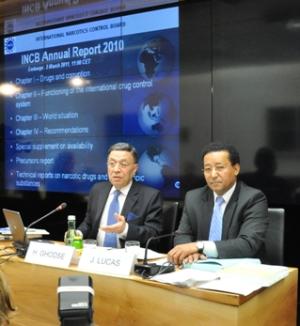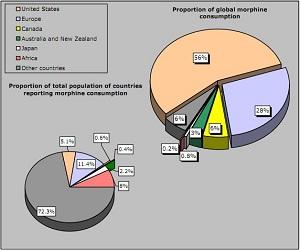Consequences of Prohibition
Drug War Issues
Politics & Advocacy
More than eight out of 10 of the world's inhabitants have little or no access to opioid pain medications, the International Narcotics Control Board (INCB) said Wednesday. The finding came as the INCB released both its Annual Report 2010 and a special report on the global availability of pain medications.

INCB head Hamid Ghodse (l) briefing reporters in Vienna (incb.org)
"Ninety percent of the licit drugs are consumed by 10% of the world's population in the United States, Australia, Canada, New Zealand and some European countries," Hamid Ghodse, the INCB's president, said in a briefing on the release of the reports. "It has to be recognized that the availability of narcotics and psychotropic medicines is indispensable to medical practice," Ghodse told reporters.
The US is by far the world's leading consumer of opioid pain medications. According to INCB figures, for every pain pill consumed per capita in Asia, Africa, or Latin America, 50 are consumed in Europe, and 300 in North America. The US alone, with 5% of the world population, consumed 56% of the world's pain pills. [Editor's Note: This does not mean that US patients who need opioids can always get prescriptions for them.]
The special report on the availability of pain medicines found that while the global supply of raw opium for licit needs is adequate, there are a number of obstacles blocking their availability in large parts of the world. The INCB identified the obstacles in descending order as concerns about addiction, reluctance to stock or prescribe, lack of training of professionals, restrictive laws, administrative problems, cost, distribution problems, lack of supply, and absence of policies around the prescribing of the drugs for pain treatment.
Lack of supply was near the bottom of the list. The INCB said opiate raw materials, including opium, poppy straw, and poppy straw concentrate were sufficient to outstrip consumption. "There is no problem whatsoever with the availability of raw materials," Ghodse said.
Ghodse called on governments to analyze the problem, identify barriers to adequate availability, and take action to reduce or remove them. The report called on governments to collect data on licit drug requirements, legislation, education and training, national drug control systems, and steps to combat misuse.
For the INCB, the flip side of barriers to adequate pain pill access in large swathes of the world is excess availability, which it said can lead to abuse and drug dependence. While the number of single doses of opioid pain medications consumed has increased four-fold in the last 20 years, driven largely by increases in synthetic opioid production, consumption in the US, for example, has increased six-fold. The US now sees more people dying of prescription drug overdoses than from illegal drugs.

morphine consumption by region (incb.org)
That is a theme repeated from last year's INCB report, when the monitoring body reported that the abuse of prescription drugs was increasingly markedly worldwide. More people were taking prescription drugs for non-medical reasons than were using heroin, cocaine, and ecstasy combined, that report said.
Another major theme for the INCB in this year's report was increasing concern over the emergence of new synthetic drugs, or what it called designer drugs. The INCB said the development of such drugs is escalating so rapidly that governments need to adopt generic bans on new substances.
The report cited 4-methyl-methcathinone, or mephedrone, which has effects similar to cocaine or amphetamines and is being marketed as bath salts under names like Ivory Wave. The drug is currently the cause of ongoing concern in the US, where it has been banned in at least four states, and in Europe, where it has been banned by the European Union.
"Mephedrone has now become a problem drug of abuse in Europe, North America, Southeast Asia and in Australia and New Zealand," the INCB report said. But mephedrone is just "one example of a large number of designer drugs that are being abused."
The European Union, for example, is monitoring 15 other methcathinone analogues alone, while Japan recently placed 51 designer drugs under control. The INCB is recommending generic bans on such substances.
"Given the health risks posed by the abuse of designer drugs, we urge governments to adopt national control measures to prevent the manufacture, trafficking in and abuse of these substances," said Ghodse.
The INCB's schizophrenic report -- increase access to licit opioid pain medications, continue to ban new drugs -- reflects its bifurcated mission. At the same time it is charged with ensuring an adequate supply of medicines to the world, it is also charged with preventing non-medical use and diversion.
This work by StoptheDrugWar.org is licensed under Creative Commons Attribution-ShareAlike 4.0 International
Comments
Pain Medications
I am hearing constantly about the wealth of pain meds that are so readily available in North America.I was conned into accepting a prescription of Fentanyl for a severe spinal problem.I told the physician that I had a 40 year heroin addiction and would need to be treated for both the pain and a long addiction.I was puzzled at the total lack of any feeling,except for the pain,which took about 6 months to succumb to my tolerance.I was curious so I looked the drug up and it has no affect on the pleasure part of the brain.
I pointed out the disparity and she just acknowledged the reality and then refused to do anything about it.It is no surprise to me that even a trained pain doctor will only prescribe drugs that have no possibility of being abused.I explained my frustration at being treated like an abuser even without first giving me a chance.I hate the methadone clinics with a passion and tried to have her prescribe either suboxone or methadone so I wouldn't have to deal with the methadone clinics.It would seem that my belief that being a legitimate pain patient means nothing,in fact,it makes it worse.10 years ago I was on a list for the NAOMI program.I suppose I was lucky,under the circumstances,not to get in.Now I'm between a rock and a really hard place.It's obvious that if there is a shortage of pain medication in the third world the problem is money.Drugs like oxycodone and Fentanyl are chemical concoctions.There is no shortage of opium and I believe the opium for medical use comes from Turkey.There is also Demerol,which comes from coal.It would seem fairly obvious that either the big drug companies only produce what is paid for or that the drugs are being diverted to the black market.Prohibition works it's magic once again,bringing pain to people who should not have to suffer.
Since being wounded in combat
Since being wounded in combat by a roadside bomb, and have a horrible pain issue ever since, I've come to believe that the "War on Drugs" is a ploy to get the drugs away from the wounded and into the hands of the affluent. In other words, the prescriptions still get written, but they don't go into the hands of the pain suffering patient; they just go under the table to whoever has the doctor on the string, or whomever the doctor has on the string.
Now I know why some nurses gave me a shot that did nothing for the pain.
As for the drugs and money confiscated, sure, some get destroyed, but given that drug consumption is the highest in the US than it's ever been, it's obviously more of a racket than a crusade.
Add new comment